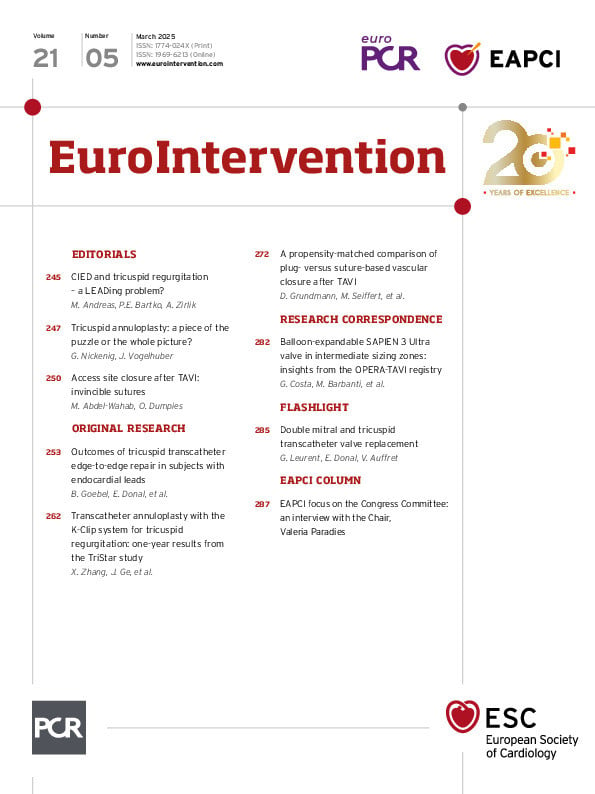This issue focuses on the continuing advances in valvular interventions, touching on a wide range of topics, from tricuspid valve procedures to valvular access closure and transcatheter aortic valve implantation sizing. Join us!
Endocardial leads and tricuspid transcatheter edge-to-edge repair
Transvalvular leads can be an obstacle to catheter-based repair. BjoÌrn Goebel, Erwan Donal and colleagues explored this challenge in the bRIGHT EU Post-Approval Study finding that tricuspid transcatheter edge- to-edge repair using the TriClip system was a safe and effective treatment option in patients with endocardial leads. Martin Andreas, Philipp Emmanuel Bartko and Andreas Zirlik contribute an editorial to accompany this study.
Plug- vs suture-based vascular closure after TAVI
Vascular access site complications after transcatheter aortic valve implantation (TAVI) are associated with increased morbidity and mortality. In a large, propensity score-matched registry analysis, David Grundmann, Moritz Seiffert and colleagues compare plug- and suture-based vascular closure strategies in transfemoral TAVI patients using the updated VARC-3 criteria. In an accompanying editorial, Mohamed Abdel-Wahab and Oliver Dumpies comment on their findings supporting a suture-based approach.
Treating tricuspid regurgitation with transcatheter annuloplasty using the K-Clip system
Xiaochun Zhang, Junbo Ge and colleagues report on the 1-year outcomes of the TriStar study which used the K-Clip tricuspid annuloplasty system to treat severe secondary tricuspid regurgitation. The authors saw a sustained reduction in tricuspid regurgitation severity, with improvements in patients’ functional status and quality-of-life outcomes as well as early evidence of right heart remodelling. Further follow-up will determine the durability as well as the safety, efficacy, and long-term benefits of this procedure. The article is accompanied by an editorial by Georg Nickenig and Johanna Vogelhuber.
Accurately sizing the SAPIEN 3 Ultra balloon-expandable valve in intermediate sizing zones
Accurate balloon-expandable valve sizing for TAVI is especially important, as the negative consequences of inaccurate sizing are multiple. With the introduction of a newly approved intermediate-sized valve, the potential for a correctly sized valve becomes more attainable, and in this research correspondence, Giuliano Costa, Marco Barbanti and colleagues analyse data from the OPERA- TAVI registry, comparing outcomes of patients receiving the balloon-expandable SAPIEN 3 Ultra in optimal or intermediate sizing zones to help understand the new valve’s performance.

